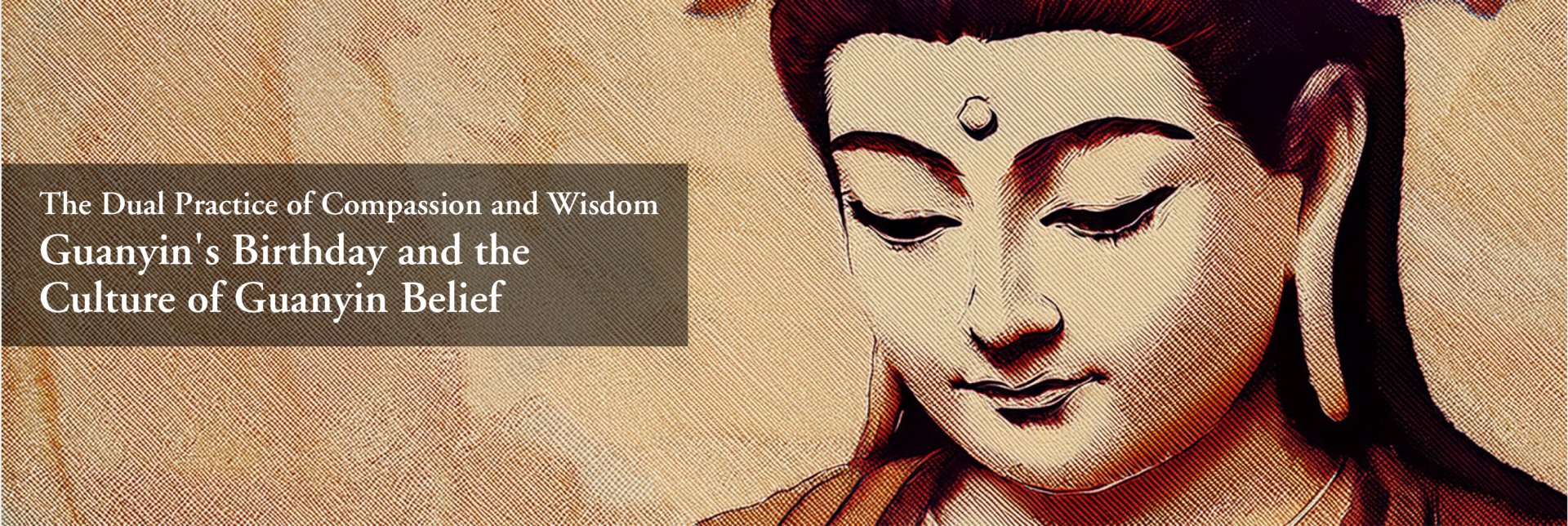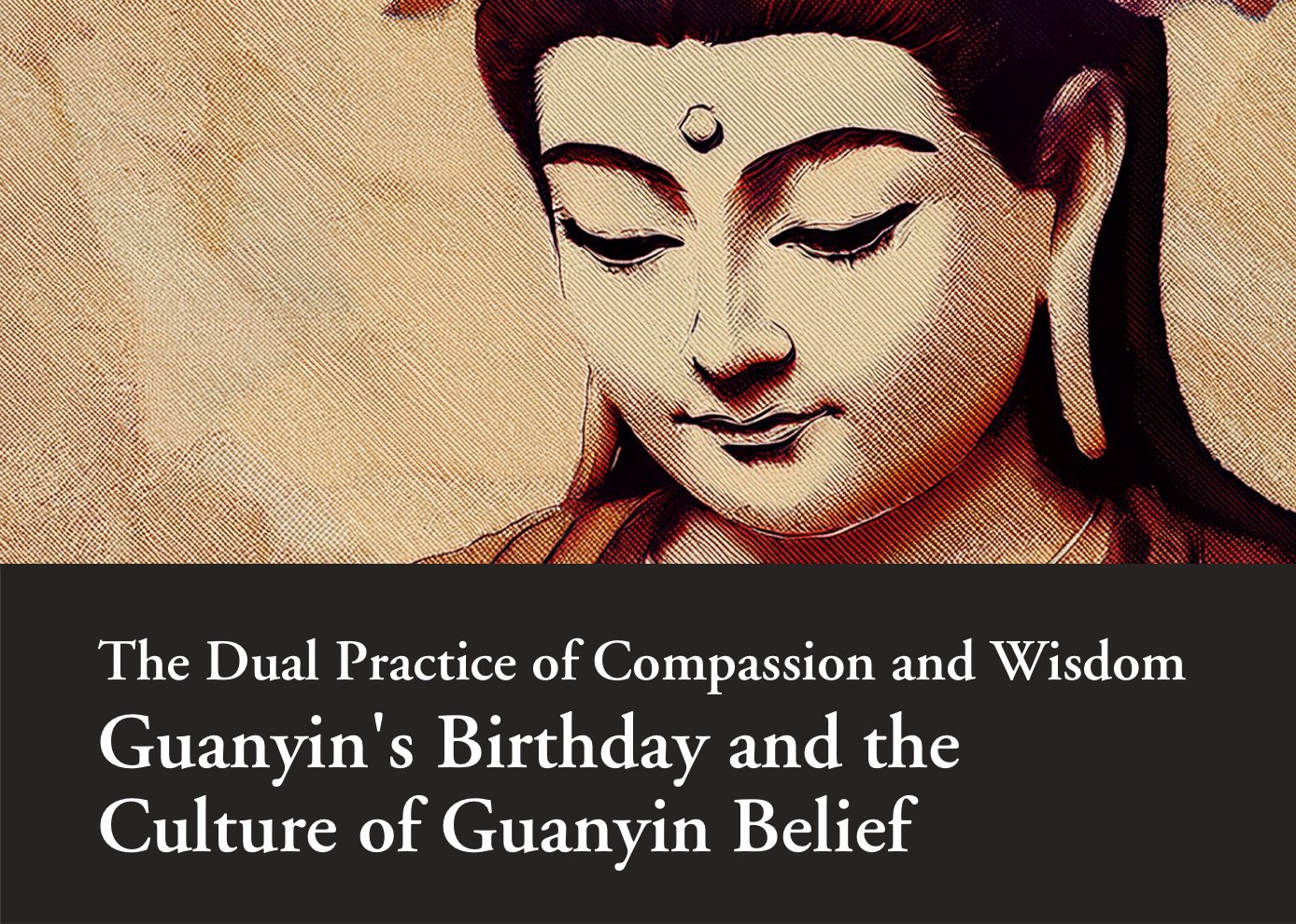The Dual Practice of Compassion and Wisdom Guanyin's Birthday and the Culture of Guanyin Belief
Many scholars have pointed out that in much of Asian society, the most well-known and beloved deity in traditional Chinese religious worship is Guanyin. Historical texts and scriptures describe Guanyin as the Bodhisattva with the deepest connection to the human world. The belief in Guanyin also represents the successful localization of Buddhism in China. Some Japanese scholars argue that in various Mulian operas, Guanyin appears as a savior, driving the plot forward.

In folk customs, there are three major dates associated with Guanyin: her birthday on the 19th day of the second lunar month, her enlightenment day on the 19th day of the sixth lunar month, and her nirvana day on the 19th day of the ninth lunar month. Additionally, the 19th day of the eleventh lunar month is considered the day Guanyin grants children, though no celebrations or commemorations are held on this day. Among the three major dates, the most widely celebrated by devotees is the 19th day of the second lunar month.
I recall my childhood living on Peel Street in Central, near the Guanyin Temple next to the Man Mo Temple in Sheung Wan. My mother would take me to the temple to pay respects to Guanyin, and there were always long lines of devotees doing the same. Today, many worshippers visit the Lin Fa Kung Temple in Tai Hang, Causeway Bay, and the Guanyin Temple in Hung Hom to honor the deity. Due to the strong devotion to Guanyin, the folk custom of "borrowing from Guanyin's treasury" on the 26th day of the first lunar month has become popular. On this day, devotees visit Guanyin temples in Hong Kong to "borrow" from Guanyin, with some even "borrowing" ten million.
Guanyin, also known as Guanshiyin or Guanzizai, originated from India. Her Indian name, "Avalokitesvara," is a masculine noun, transliterated as "Avalokiteshvara." Chinese monks translated it as "Guanshiyin" or "Guanyin." According to current research, the Chinese translation "Guanshiyin" first appeared in the *Sutra of Infinite Life*, translated by the Indian monk Kang Senghui in the 3rd century. It was not until the 5th century, when Kumarajiva translated the *Lotus Sutra*'s "Universal Gate Chapter," that the name "Guanshiyin" gained widespread recognition. In 663 AD, the Tang Dynasty monk Xuanzang explained that "Avalokitesvara" is composed of two Sanskrit words: "avalokita," meaning "to observe," and "isvara," meaning "lord" or "sovereign." Thus, the full meaning is "the lord who observes," which is why the *Heart Sutra* begins with "The Bodhisattva who observes freely."
"Guanshiyin" originally meant "observing the sounds of the world," symbolizing the Bodhisattva's active compassion and desire to save the world. It also represents the cries of suffering beings seeking salvation. On the other hand, "Guanzizai" refers to the Bodhisattva's profound understanding of the world, achieving a state of complete spiritual enlightenment and perfect wisdom. Guanyin embodies the Buddhist concept of "the dual practice of compassion and wisdom." Over time, as people focused more on solving immediate problems rather than pursuing ultimate wisdom, the emphasis shifted from seeking wisdom ("Guanzizai") to seeking salvation in this life ("Guanshiyin").
In Hong Kong, many have visited the Chi Lin Nunnery and seen the Bodhisattva seated on a rock, known as the Water-Moon Guanyin. The Chinese depiction of Water-Moon Guanyin differs significantly from the Indian version. In ancient India, the Guanyin enshrined at the Deer Park was male, as traditional Buddhism held a lower view of women, believing they could only practice virtue after being reborn as men. Some Indian Guanyin statues depict a male figure holding a lotus stem, with downcast eyes, a bare upper body, and thin clothing covering the lower body.
When Buddhism spread from India to China, the depiction of Guanyin evolved, expanding to include various forms such as a Bodhisattva, a nun, a young man or woman, or an elderly woman. This led to the creation of the "Thirty-Three Forms of Guanyin," including Water-Moon Guanyin and White-Robed Guanyin. Traditional Chinese culture often associates women with compassion and kindness, which is reflected in the maternal characteristics of Chinese Guanyin statues.
At Chi Lin Nunnery, the Guanyin statue is depicted with a full moon behind her, a small Buddha image on her head, her left hand resting on her knee, and her right hand hanging down. She sits leisurely on a rock, with one foot raised and the other resting on a lotus in a pool, smiling at devotees. During the Tang Dynasty, Water-Moon Guanyin was depicted as male with a beard, but by the Song Dynasty, female representations emerged. By the Yuan Dynasty, Water-Moon Guanyin was often portrayed as an elegant woman in a long robe, reflecting the Sinicization of Buddhism. In Guangdong, the South Sea Guanyin is worshipped, depicted holding a willow branch and a purification vase, seated on a rock with Sudhana and Dragon Girl by her side.

In Chinese folk culture, the "Child-Granting Guanyin" is also popular. While ancient Indian Buddhist texts do not mention this form of Guanyin, the story of the Child-Granting Guanyin is a testament to the localization of Buddhism in China. According to the *Records of Guanyin's Miracles*, during the Jin Dynasty, a man named Wang Min from Shandong had no son. His wife often prayed to Guanyin, and one day, Wang met a monk who told him, "After I die, I will be your son." Soon after, the monk passed away, and Wang's wife became pregnant, giving birth to a son who became Wang's heir. Another story from *The Compassionate Ferry of the South Sea* tells of a man named Xu Jin from Huizhou who prayed for a son. A deity appeared in his dream, promising him a son if he recited scriptures daily. Xu followed the instructions, and his son was eventually born and achieved great success.
These stories, though mythical, reflect two key aspects of Chinese culture: first, the traditional belief that "having no heir is the greatest unfilial act," as it would disrupt the family lineage; second, the Chinese concept of karma, where Buddhists believe that good deeds, such as chanting sutras, lead to positive outcomes. In traditional Chinese society, the importance of male heirs led to practices such as women "stealing" lotus lamps from Guanyin temples, as the word for "lamp" (deng) sounds like "son" (ding), symbolizing the wish for a male child. Over time, these folk practices added the "child-granting" function to Guanyin's role, illustrating the Sinicization and secularization of Buddhism.
As for the offerings and rituals during Guanyin's birthday, devotees can purchase paper offerings such as Guanyin's robes at temples. Common offerings include incense, candles, fresh flowers, vegetarian food, and pastries, symbolizing purity and reverence. Some devotees also offer oranges, apples, longevity peaches, and bananas. Flowers such as lilies, narcissus, and orchids are popular, as are longevity noodles and three cups of tea.
In conclusion, the religious culture surrounding Guanyin remains highly influential today. Guanyin's dual practice of compassion and wisdom, encouraging people to live with kindness, holds universal value.
Reference
Book
1. 顏素慧:《觀音小百科:第一本親近觀音的書》(臺北:橡樹林文化,2001)。
2. 于君方:〈中國佛教與觀音信仰〉,收入陳益源主編:《府城大觀音亭與觀音信仰研究 》(臺北:里仁書局,2015),頁1-20。
3. 謝永昌:《香港觀音廟堂巡禮》(香港:中華文教交流服務中心,2008)。
4. 駱慧瑛:《觀心自在:香港觀音誕與觀音信仰探源》(香港:天地圖書有限公司,2020)。
5. 于君方:《觀音——菩薩中國化的演變》(北京:商務印書館,2012)。
All articles/videos are prohibited from reproducing without the permission of the copyright holder.




Welcome to leave a message:
Please Sign In/Sign Up as a member and leave a message